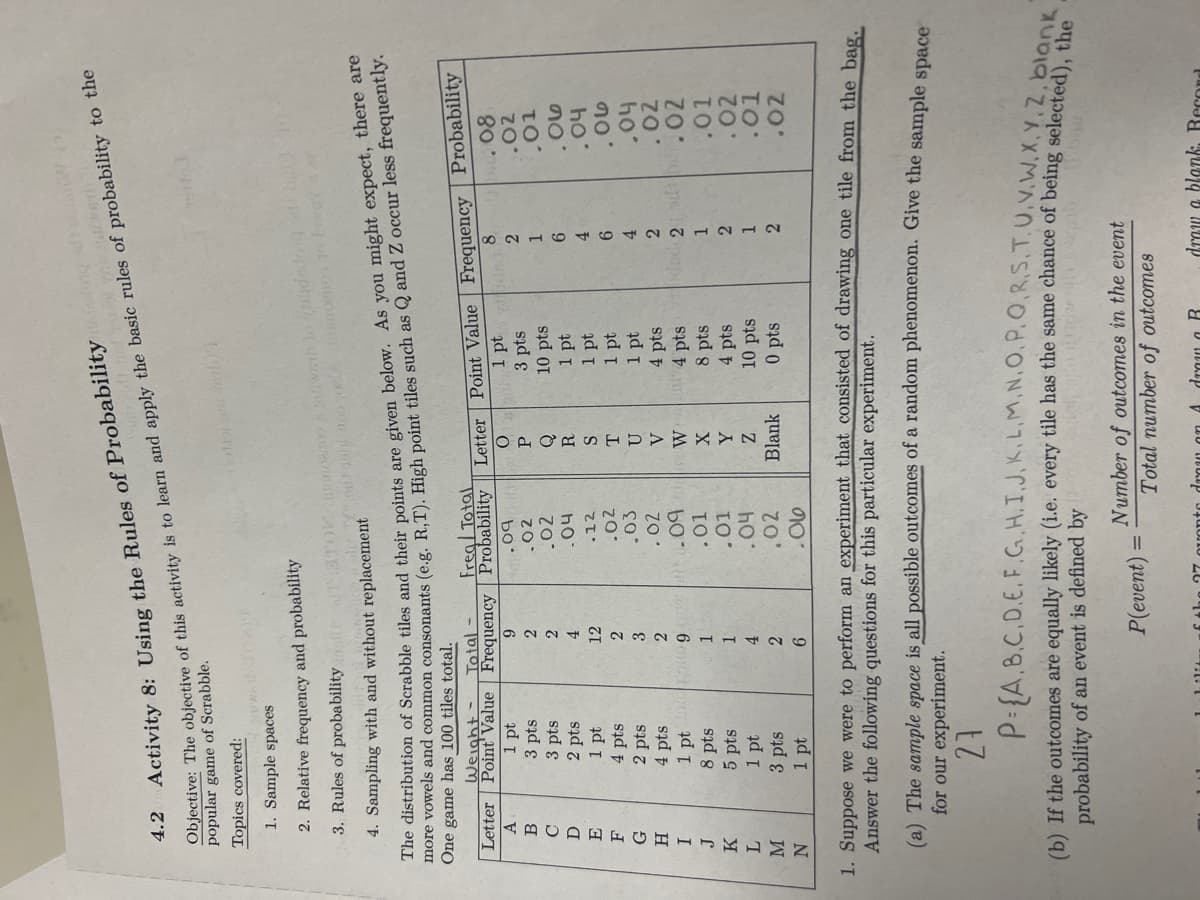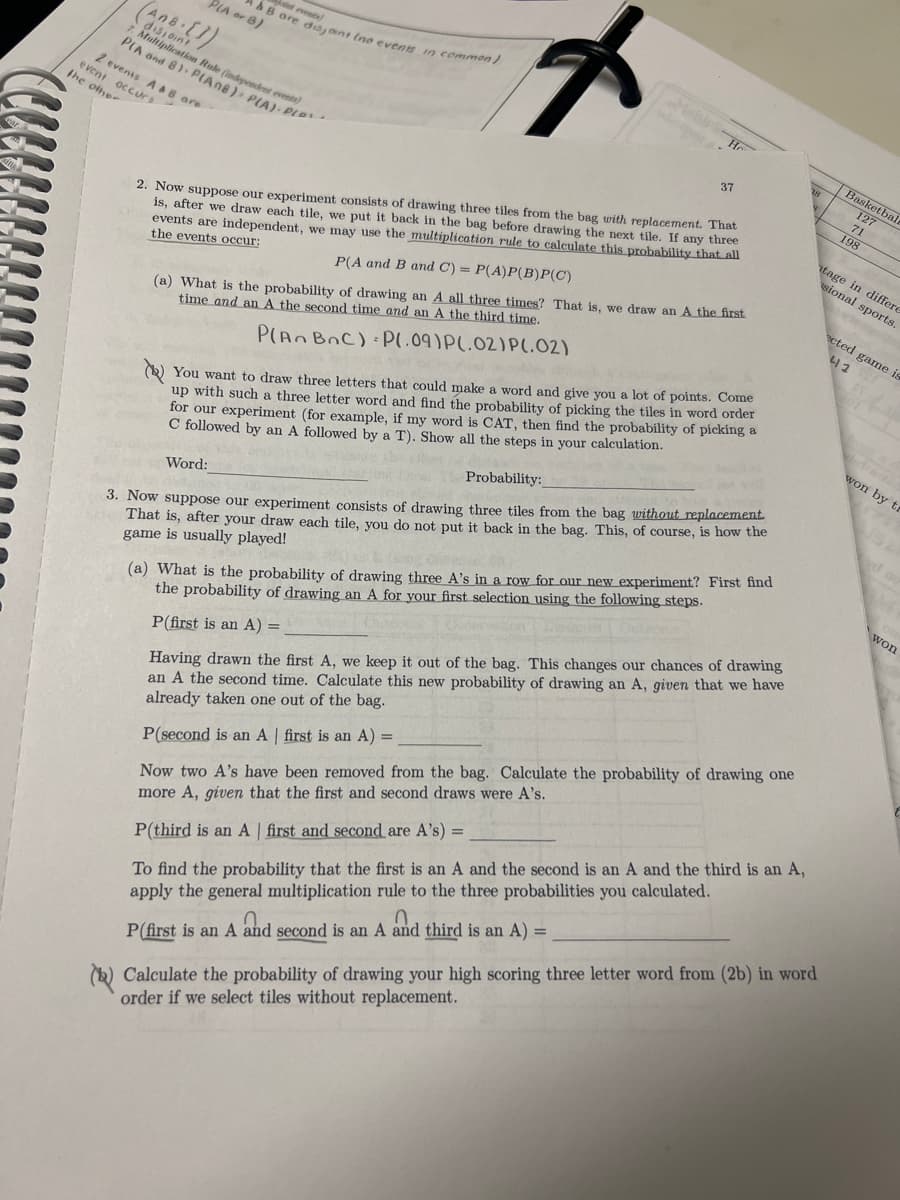Basketbala 37 127 71 198 2. Now suppose our experiment consists of drawing three tiles from the bag with replacement. That is, after we draw each tile, we put it back in the bag before drawing the next tile. If any three events are independent, we may use the multiplication rule to calculate this probability that al the events occur: tage in differe sional sports. (a) What is the probability of drawing an A all three times? That is, we draw an A the first time and an A the second time and an A the third time. P(A and B and C) = P(A)P(B)P(C) cted game is 42 P(An BnC) PO.09)PL.02)Pl.02) ) You want to draw three letters that could make a word and give you a lot of points. Come up with such a three letter word and find the probability of picking the tiles in word order for our experiment (for example, if my word is CAT, then find the probability of picking a C followed by an A followed by a T). Show all the steps in your calculation. won by tr Probability: 3. Now suppose our experiment consists of drawing three tiles from the bag without replacement. That is, after your draw each tile, you do not put it back in the bag. This, of course, is how the game is usually played! Word: (a) What is the probability of drawing three A's in a row for our new experiment? First find the probability of drawing an A for your first selection using the following steps. won Having drawn the first A, we keep it out of the bag. This changes our chances of drawing an A the second time. Calculate this new probability of drawing an A, given that we have already taken one out of the bag. P(first is an A) = Now two A's have been removed from the bag. Calculate the probability of drawing one more A, given that the first and second draws were A's. P(second is an A | first is an A) = To find the probability that the first is an A and the second is an A and the third is an A, apply the general multiplication rule to the three probabilities you calculated. P(third is an A | first and second are A's) = b) Calculate the probability of drawing your high scoring three letter word from (2b) in word order if we select tiles without replacement. P(first is an A and second is an A and third is an A) =
Basketbala 37 127 71 198 2. Now suppose our experiment consists of drawing three tiles from the bag with replacement. That is, after we draw each tile, we put it back in the bag before drawing the next tile. If any three events are independent, we may use the multiplication rule to calculate this probability that al the events occur: tage in differe sional sports. (a) What is the probability of drawing an A all three times? That is, we draw an A the first time and an A the second time and an A the third time. P(A and B and C) = P(A)P(B)P(C) cted game is 42 P(An BnC) PO.09)PL.02)Pl.02) ) You want to draw three letters that could make a word and give you a lot of points. Come up with such a three letter word and find the probability of picking the tiles in word order for our experiment (for example, if my word is CAT, then find the probability of picking a C followed by an A followed by a T). Show all the steps in your calculation. won by tr Probability: 3. Now suppose our experiment consists of drawing three tiles from the bag without replacement. That is, after your draw each tile, you do not put it back in the bag. This, of course, is how the game is usually played! Word: (a) What is the probability of drawing three A's in a row for our new experiment? First find the probability of drawing an A for your first selection using the following steps. won Having drawn the first A, we keep it out of the bag. This changes our chances of drawing an A the second time. Calculate this new probability of drawing an A, given that we have already taken one out of the bag. P(first is an A) = Now two A's have been removed from the bag. Calculate the probability of drawing one more A, given that the first and second draws were A's. P(second is an A | first is an A) = To find the probability that the first is an A and the second is an A and the third is an A, apply the general multiplication rule to the three probabilities you calculated. P(third is an A | first and second are A's) = b) Calculate the probability of drawing your high scoring three letter word from (2b) in word order if we select tiles without replacement. P(first is an A and second is an A and third is an A) =
Algebra and Trigonometry (MindTap Course List)
4th Edition
ISBN:9781305071742
Author:James Stewart, Lothar Redlin, Saleem Watson
Publisher:James Stewart, Lothar Redlin, Saleem Watson
Chapter14: Counting And Probability
Section14.2: Probability
Problem 1E: The set of all possible outcomes of an experiment is called the ____________ _____________. A subset...
Related questions
Question

Transcribed Image Text:PORS UYWXY
Objective: of is to learn and apply the basic rules of to the
more vowels (e.g. R,T). High point tiles such as Q and Z frequently.
4.2
Activity 8: Using the Rules of Probability
popular game of Scrabble.
Topics covered:
1. Sample spaces
2. Relative frequency and probability
inono wsih lo ilidsdongod
3. Rules of probability TTOV
4. Sampling with and without replacement
momustribution of Scrabble tiles and their points are given below. As you might expect, there are
One game has 100 tiles total.
Total -
Letter Point Value Frequency Probability
08
Freg/Total
Point' Value Frequency | Probability
1 pt
3 pts
3 pts
2 pts
1 pt
4 pts
2 pts
4 pts
1 pt
8 pts
5 pts
1 pt
3 pts
1 pt
Letter
1 pt
3 pts
10 pts
1 pt
bo
.02
02
A.
B
2.
2.
.02
9.
4.
12
.12
ho
4.
1 pt
1 pt
4 pts
4 pts
8 pts
4 pts
10 pts
9.
.04
02
02
G
3
4.
.02
2.
Nlod 2 t
H.
2.
I
.01
02
.01
1.
K
2.
.04
4.
2
Z
Blank
.02
0 pts
.02
2.
9.
1. Suppose we were to perform an experiment that consisted of drawing one tile from the bag.
Answer the following questions for this particular experiment.
(a) The sample space is all possible outcomes of a random phenomenon. Give the sample space
for our experiment.
P:{A.B.C.D.E.F.G. H. I,J, K.L,M.N.
P.Q.R.S.T.U.V.W.X.Y.Z. blank
(b) If the outcomes are equally likely (i.e. every tile has the same chance of being selectedank
probability of an event is defined by
Number of outcomes in the event
Total number of outcomes
P(event) =
010.an 4 drau a R
draw a blank. Becond
1lit.

Transcribed Image Text:vt events)
PLA or 8)
AB ore da nt (no events in common)
(disioint
7. Multiplication Rule (independent events)
PIA and 8). PIAO8): PUA) PIR
2 events A a8 are
Basketbals
event occurs
the other
37
127
71
198
2. Now suppose our experiment consists of drawing three tiles from the bag with replacement. That
is, after we draw each tile, we put it back in the bag before drawing the nexct tile. If any three
events are independent, we may use the multiplication rule to calculate this probability that all
the events occur:
tage in differe
sional sports.
(a) What is the probability of drawing an A all three times? That is, we draw an A the first.
time and an A the second time and an A the third time.
cted game is
P(A and B and C) = P(A)P(B)P(C)
k) You want to draw three letters that could make a word and give you a lot of points. Come
up with such a three letter word and find the probability of picking the tiles in word order
for our experiment (for example, if my word is CAT, then find the probability of picking a
C followed by an A followed by a T). Show all the steps in your calculation.
PlAn BnC) PL.09)PL.02) P(.02)
won by t.
3. Now suppose our experiment consists of drawing three tiles from the bag without replacement.
That is, after your draw each tile, you do not put it back in the bag. This, of course, is how the
game is usually played!
Probability:
Word:
(a) What is the probability of drawing three A's in a row for our new experiment? First find
the probability of drawing an A for your first selection using the following steps.
won
Having drawn the first A, we keep it out of the bag. This changes our chances of drawing
an A the second time. Calculate this new probability of drawing an A, given that we have
already taken one out of the bag.
P(first is an A) =
Now two A's have been removed from the bag. Calculate the probability of drawing one
more A, given that the first and second draws were A's.
P(second is an A | first is an A) =
To find the probability that the first is an A and the second is an A and the third is an A,
apply the general multiplication rule to the three probabilities you calculated.
P(third is an A | first and second are A's) =
b) Calculate the probability of drawing your high scoring three letter word from (2b) in word
order if we select tiles without replacement.
P(first is an A and second is an A and third is an A) =
Expert Solution
This question has been solved!
Explore an expertly crafted, step-by-step solution for a thorough understanding of key concepts.
This is a popular solution!
Trending now
This is a popular solution!
Step by step
Solved in 3 steps with 3 images

Recommended textbooks for you

Algebra and Trigonometry (MindTap Course List)
Algebra
ISBN:
9781305071742
Author:
James Stewart, Lothar Redlin, Saleem Watson
Publisher:
Cengage Learning

College Algebra
Algebra
ISBN:
9781305115545
Author:
James Stewart, Lothar Redlin, Saleem Watson
Publisher:
Cengage Learning

Algebra & Trigonometry with Analytic Geometry
Algebra
ISBN:
9781133382119
Author:
Swokowski
Publisher:
Cengage

Algebra and Trigonometry (MindTap Course List)
Algebra
ISBN:
9781305071742
Author:
James Stewart, Lothar Redlin, Saleem Watson
Publisher:
Cengage Learning

College Algebra
Algebra
ISBN:
9781305115545
Author:
James Stewart, Lothar Redlin, Saleem Watson
Publisher:
Cengage Learning

Algebra & Trigonometry with Analytic Geometry
Algebra
ISBN:
9781133382119
Author:
Swokowski
Publisher:
Cengage